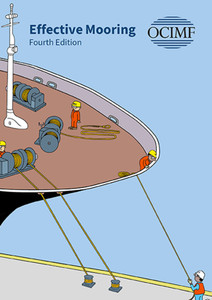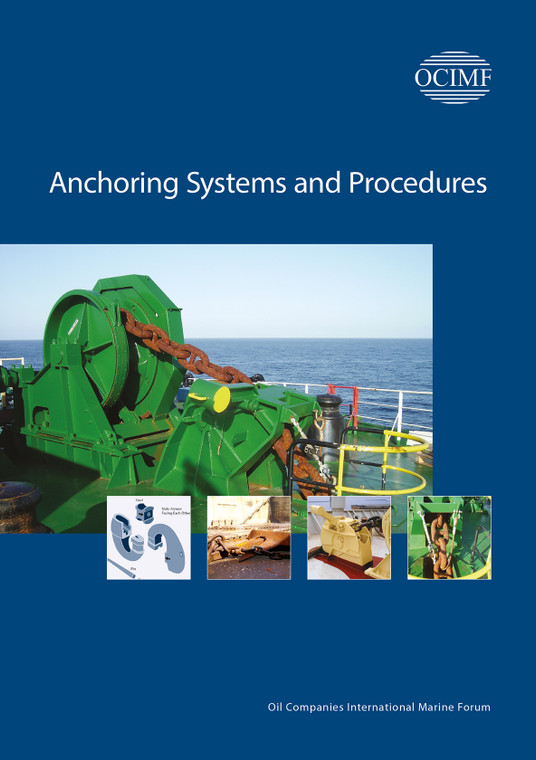
This publication provides recommendations and guidance on safe operation and satisfactory performance of anchoring systems, including design considerations, operating procedures and routine maintenance. It is applicable to anchoring systems and procedures on all types of ship, irrespective of size.
Following an increase in the number of incidents involving anchor losses, windlass motor failures and associated personnel injuries, OCIMF revised and updated the original 1982 publication to highlight the lessons learnt from incidents, provide improved information on anchoring practices and recognise advances made in anchor systems. The publication assesses the design capabilities and limitations of anchoring systems and equipment with the aim of enhancing the safety of operations.
This publication, which supersedes the 1st edition of ‘Anchoring Systems and Procedures for Large Tankers’, published in 1982, has been prepared by OCIMF to provide recommendations and guidance with the aim of promoting the safe operation and satisfactory performance of anchoring systems.
As background to the development of this revised publication; concerns had been expressed, by OCIMF member companies and others, about an increase in the number of incidents involving anchor losses, windlass motor failures and associated personnel injuries. A review of third party anchoring incidents by an OCIMF member highlighted the following particular issues:
- A number of incidents involving personnel injury and exposure of personnel to hazards during anchoring operations
- the loss of anchors and cables in relatively benign environmental conditions
- anchoring systems suffering significant damage in harsh environmental conditions
- incidents involving anchors dragging, with an associated risk of damage to third parties and the involved vessel
- inability to recover an anchor using the ship’s equipment
- reports of windlasses and drive motors being damaged due to excessive loads
- maintenance-related failures, i.e. failures caused by the lack of, or improper, maintenance.
Common factors were identified that contributed to these operational incidents and equipment failures, which included the following:
- Poor seamanship and a general lack of appreciation of the impact of deteriorating environmental conditions on anchoring system loads while remaining anchored or attempting to recover anchors
- improper operational procedures leading to excessive loads being placed on windlasses while in gear
- failure of anchor and chain components including flukes, shanks, shackles, swivels and common links.
As a result of the review, it was agreed to revise and update the information contained in the original 1982 publication to assist in promulgating the lessons learnt from incidents, to provide improved information on anchoring practices and to recognise advances made in anchor systems in the intervening years. In particular, this publication highlights the design capabilities and limitations of anchoring systems and equipment with the aim of enhancing the safety of operations.
The scope of this publication addresses anchoring systems and procedures that are applicable to all vessel types, irrespective of their size.
Section
1
Purpose
and
Scope
Section
2
Issues
Associated
with
Anchoring
Systems
and
Procedures
Section
3
General
Description
of
Anchoring
Systems
3.1
Anchoring
System
3.2
Anchors
3.3
Chain
Cable
3.4
Hawse
Pipe
3.5
Anchor
Lashing
3.6
Chain
Stopper
3.7
Windlass
3.8
Drive
Units
3.9
Windlass
Control
Systems
3.10
Spurling
Pipe
and
Chain
Locker
Section
4
Design
Considerations
4.1
Design
Standard
4.2
Design
Philosophy
of
Anchoring
Equipment
4.3
Environmental
Forces
Acting
on
a
Ship
at
Anchor
4.4
Anchors
4.5
Chain
Cable
4.6
Chain
Stopper
4.7
Windlass
4.8
Testing
of
Anchor
Equipment
and
Systems
4.9
Interface
Between
Ship
Structure
and
Anchoring
Equipment
4.10
Arrangement
of
Equipment
4.11
Additional
Equipment
Section
5
Operational
Procedures
5.1
Anchoring
Procedures
5.2
Maintaining
an
Anchor
Watch
5.3
Getting
Underway
5.4
Use
of
Anchors
in
an
Emergency
Section
6
Maintenance
Issues
6.1
Routine
Maintenance
6.2
Surveys
and
Inspections
During
Refit
Appendices
A
An
Example
of
Typical
Planned
Maintenance
Activities
B
An
Example
of
Typical
Refit
Inspection,
Survey
and
Maintenance
Activities
C
Example
Certification
for
Anchor
Chain
Cable
and
Chain
Cable
Fittings
The Oil Companies International Marine Forum (OCIMF) is a voluntary association of oil companies with an interest in the shipment and terminalling of crude oil, oil products, petrochemicals and gas. OCIMF focuses exclusively on preventing harm to people and the environment by promoting best practice in the design, construction and operation of tankers, barges and offshore vessels and their interfaces with terminals. Learn more at www.ocimf.org
- Number of Pages:
- 86
- ISBN:
- 9781856094047
- Published Date:
- October 2010
- Binding Format:
- Hardback
- Book Height:
- 304 mm
- Book Width:
- 214 mm
- Weight:
- 0.8 kg
- Author:
Oil Companies International Marine Forum
- Preview:
- Yes






